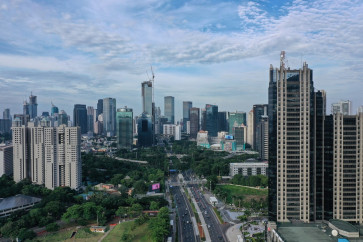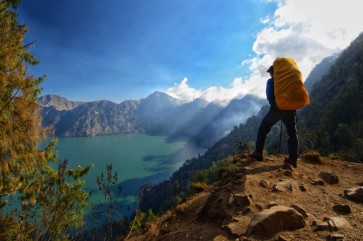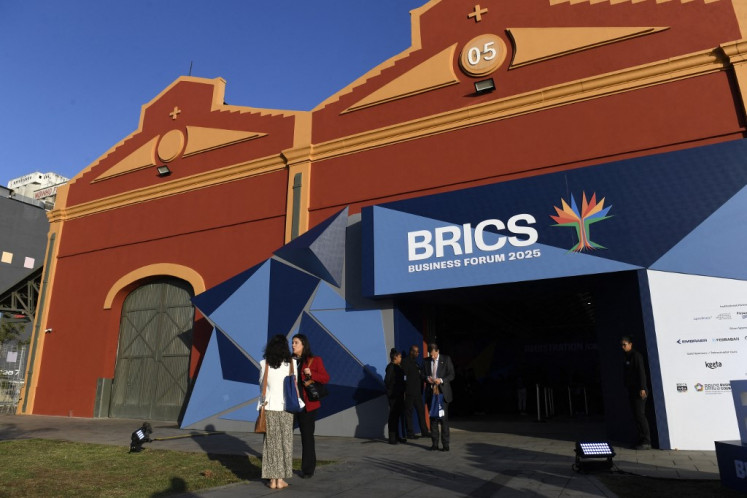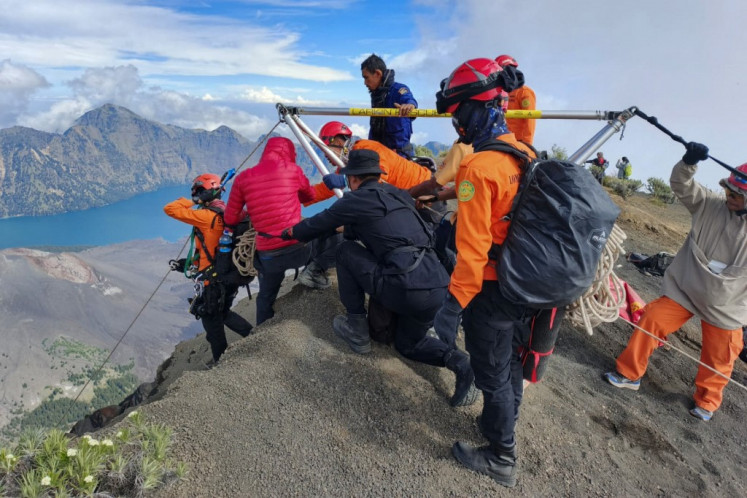Popular Reads
Top Results
Can't find what you're looking for?
View all search resultsPopular Reads
Top Results
Can't find what you're looking for?
View all search resultsIndonesia through the lens
A photography timeline is on display at the âIndonesia through âThe Looking Glassââ exhibition at Erasmus Huis, South Jakarta
Change text size
Gift Premium Articles
to Anyone
 A photography timeline is on display at the âIndonesia through âThe Looking Glassââ exhibition at Erasmus Huis, South Jakarta. (JP/Wendra Ajistyatama)" border="0" height="341" width="512">A photography timeline is on display at the âIndonesia through âThe Looking Glassââ exhibition at Erasmus Huis, South Jakarta. (JP/Wendra Ajistyatama)
A photography timeline is on display at the âIndonesia through âThe Looking Glassââ exhibition at Erasmus Huis, South Jakarta. (JP/Wendra Ajistyatama)" border="0" height="341" width="512">A photography timeline is on display at the âIndonesia through âThe Looking Glassââ exhibition at Erasmus Huis, South Jakarta. (JP/Wendra Ajistyatama)Before digital took photography by storm, there was a time when photo documentation was made on glass plates.
The history of photographic technology really started in the early 19th century when French artist and physicist Louis Daguerre introduced his Daguerreotype process of photography in 1839.
According to the ongoing âIndonesia through âThe Looking Glassââ exhibition, the technology reached Indonesia within five years with an assignment conducted by German Adolph Schaefer to document archaeological remains.
Schaefer documented sculptures and temples in the East Indies, now Indonesia, using Daguerreotypes that recorded positive images on tin. The work was discontinued because of the high cost of production.
Dutch-Flemish engraver Isodorus van Kinsbergen and Indonesian Kassian Cephas carried on a similar assignment from the 1850s until the 1880s by using glass plates, which were first used by Englishman John Herschel in 1839.
Kassian was Indonesiaâs first indigenous professional photographer.
Other photographers used the same approach until roll film was invented in 1885 and slowly replaced glass plates. American George Eastman, founder of Eastman Kodak, popularized the use of roll film in bringing photography to the mainstream market.
Nevertheless, plates were reportedly still used until the early 20th century because the technology produced high quality results, which were needed to produce meticulous work, such as that in the Borobudur Temple conservation project.
After the introduction of roll film, the photography world was amazed by the Brownie, the first ever popular low-cost camera, which introduced the snapshot concept in 1900.
 Sumatran women: Sumatran women and children in the early 20th century, photographed by G.P. Rouffaer. (Courtesy of Erasmus Huis/KITLV)
Sumatran women: Sumatran women and children in the early 20th century, photographed by G.P. Rouffaer. (Courtesy of Erasmus Huis/KITLV)
Eighty years later, digital technology reformed photography â turning the art into something more effortless and an inseparable part of most peopleâs daily lives.
In a spirit of appreciating the technology used in the early years of photography, Erasmus Huis is collaborating with 3Buwana Musea Komunika and Architecture Documentation Center to host the exhibition until Nov. 8.
The exhibition showcases historical collections from, among others, the KITLV (The Royal Netherlands Institute of Southeast Asian and Caribbean Studies), the National Museum, the Bank Indonesia Museum, archives of Bank Mandiri as well as Tangerang-based Museum Benteng Heritage.
âIt is a fascinating fact that many Indonesians are familiar with photography. However, few of them know about a great collection of glass plates which displays pieces of our history,â the exhibitionâs curator Amir Sidharta told The Jakarta Post.
âWeâre concerned about the possibility that most Indonesians, especially photography lovers, know very little about photography in its early days â that required a complex process as compared to todayâs digital photography.â
He said that the exhibition was held in the hope of reminding people about photographyâs complexity, allowing people to appreciate photography and its technology more.
âBy the end of the day, weâd love to see Indonesians who arenât just consuming photography products, but also individuals who are more creative and explorative in handling digital photography,â Amir says.
In the exhibition, visitors are provided with comprehensive yet simple information about photographyâs timeline in Indonesia along with replicas of the glass plate collection.
span class="caption" style="width: 510px;">A photography timeline is on display at the 'Indonesia through 'The Looking Glass'' exhibition at Erasmus Huis, South Jakarta. (JP/Wendra Ajistyatama) Before digital took photography by storm, there was a time when photo documentation was made on glass plates. The history of photographic technology really started in the early 19th century when French artist and physicist Louis Daguerre introduced his Daguerreotype process of photography in 1839. Sumatran women: Sumatran women and children in the early 20th century, photographed by G.P. Rouffaer. (Courtesy of Erasmus Huis/KITLV) 'We're concerned about the possibility that most Indonesians, especially photography lovers, know very little about photography in its early days ' that required a complex process as compared to today's digital photography.' A 55-model Ensign midget camera of the 1934-1940. (JP/Wendra Ajistyatama) Indonesia through 'The Looking Glass'
A
According to the ongoing 'Indonesia through 'The Looking Glass'' exhibition, the technology reached Indonesia within five years with an assignment conducted by German Adolph Schaefer to document archaeological remains.
Schaefer documented sculptures and temples in the East Indies, now Indonesia, using Daguerreotypes that recorded positive images on tin. The work was discontinued because of the high cost of production.
Dutch-Flemish engraver Isodorus van Kinsbergen and Indonesian Kassian Cephas carried on a similar assignment from the 1850s until the 1880s by using glass plates, which were first used by Englishman John Herschel in 1839.
Kassian was Indonesia's first indigenous professional photographer.
Other photographers used the same approach until roll film was invented in 1885 and slowly replaced glass plates. American George Eastman, founder of Eastman Kodak, popularized the use of roll film in bringing photography to the mainstream market.
Nevertheless, plates were reportedly still used until the early 20th century because the technology produced high quality results, which were needed to produce meticulous work, such as that in the Borobudur Temple conservation project.
After the introduction of roll film, the photography world was amazed by the Brownie, the first ever popular low-cost camera, which introduced the snapshot concept in 1900.
Eighty years later, digital technology reformed photography ' turning the art into something more effortless and an inseparable part of most people's daily lives.
In a spirit of appreciating the technology used in the early years of photography, Erasmus Huis is collaborating with 3Buwana Musea Komunika and Architecture Documentation Center to host the exhibition until Nov. 8.
The exhibition showcases historical collections from, among others, the KITLV (The Royal Netherlands Institute of Southeast Asian and Caribbean Studies), the National Museum, the Bank Indonesia Museum, archives of Bank Mandiri as well as Tangerang-based Museum Benteng Heritage.
'It is a fascinating fact that many Indonesians are familiar with photography. However, few of them know about a great collection of glass plates which displays pieces of our history,' the exhibition's curator Amir Sidharta told The Jakarta Post.
He said that the exhibition was held in the hope of reminding people about photography's complexity, allowing people to appreciate photography and its technology more.
'By the end of the day, we'd love to see Indonesians who aren't just consuming photography products, but also individuals who are more creative and explorative in handling digital photography,' Amir says.
In the exhibition, visitors are provided with comprehensive yet simple information about photography's timeline in Indonesia along with replicas of the glass plate collection.
A replica of a glass plate of Mangkunegara VIII with his wife and children at Parang Supito, which was taken in 1931 by an unknown photographer, for example, is among the exhibition's highlights. The item is courtesy of the KITLV.
The exhibition also displays milestones in photography ' from around 5 and 4 BC when Chinese philosopher Mo Ti and Greek mathematician Aristotle described a pinhole camera, to the early 2000s when Japan's Sharp introduced the world first's camera phone.
For those who aren't familiar with dark rooms, the exhibition presents a replica with information on the basic principles, wet area and dry area etc. The exhibition also features a stunning collection of real and replica old cameras ' the magical boxes which have created fascinating images for almost two centuries.
'There are at least 30 cameras, real and replica, in the exhibition, which are courtesy of Museum Benteng Heritage,' Amir says. 'We are not showing off today's digital cameras because there are simply too many types.' The collections include a Camera Lucida of the 1800s and a Nikon F3 single-lens-reflex camera of the 1980s. With its amazing glass plate collection, Amir hopes the exhibition could further trigger research in the future.
'The glass plate has so much potential for advanced research. I hope one day we'll be seeing more studies on this in order to preserve the extraordinary technology.'
Erasmus Huis
Jl. H.R. Rasuna Said Kav. S-3 Kuningan
South Jakarta
erasmushuis.org
Your Opinion Matters
Share your experiences, suggestions, and any issues you've encountered on The Jakarta Post. We're here to listen.
Thank You
Thank you for sharing your thoughts. We appreciate your feedback.
Share options
Quickly share this news with your network—keep everyone informed with just a single click!
Gift Premium Articles
to Anyone
Share the best of The Jakarta Post with friends, family, or colleagues. As a subscriber, you can gift 3 to 5 articles each month that anyone can read—no subscription needed!
Continue in the app
Get the best experience—faster access, exclusive features, and a seamless way to stay updated.









